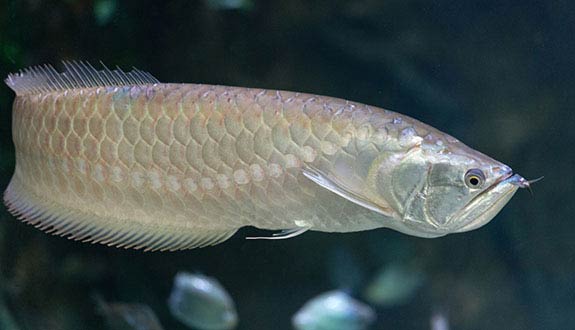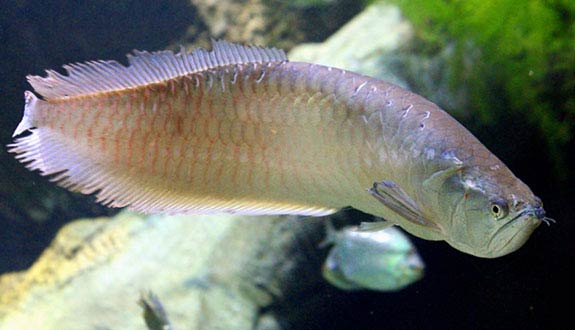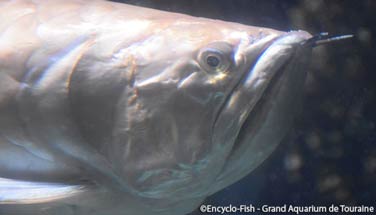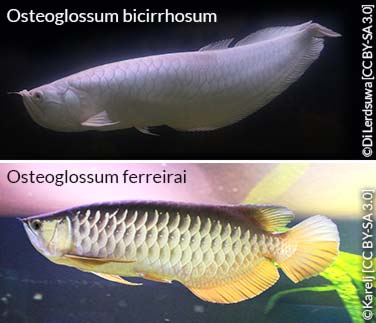

Silver arowana
(Osteoglossum bicirrhosum)

Many thanks to Imex Cichlidé!
Alternative species (click on the thumbnail to see the card)
Names
Scientific name
Osteoglossum bicirrhosum
Ischnosoma bicirrhosum
Osteoglossum vandelli
Common name
Silver arowana
Origin

Origin: Brazil, Peru, Colombia, Ecuador, French Guiana, Guyana
Biotope: Amazonian
Dimorphism

The male has an anal fin longer than the female
Group

Osteoglossidae
Volume

3000 L / 660 imp gal / 800 US gal
Parameters

T°: 24 à 28°C or 75 to 82°F
pH: 7
Hardness: 3 to 6°dGH
Difficulty

Hard
Size

120 cm (48")
Longevity

20 years
Living zone

Top
Individuals

Solitary
Food
How to feed the Silver arowana?
Food
How to feed the Silver arowana?
Piscivorous, it will prefer live prey (fish and insects). It will also eat fish or beef meat, mussels, shrimp, stick. You can occasionally supplement its diet with some vegetables, but most of its diet will be piscivorous.
Behavior
What kind of behavior does the Silver arowana have?
Behavior
What kind of behavior does the Silver arowana have?
Of a rather aggressive nature, this mastodon is a surface predator.
It must be maintained alone or in trio when volume permits it (a group of several individuals will always form a separate hierarchy).
They can tame themselves to the point of eating in your hand!
Cohabitation
Who can live with the Silver arowana?
Cohabitation
Who can live with the Silver arowana?
When they are young, they can coexist among congeners up to 10 individuals. Later, you can associate them with large species of cichlids or even freshwater stingrays. For example, two large Pleco can avoid the appearance of algae and will not disturb the Arowanas since they live at the bottom of the aquarium.
Breeding
How to breed the Silver arowana?
Breeding
How to breed the Silver arowana?
Breeding is often hindered by lack of space in captivity. Breeders have large basins provided for this purpose in which they maintain about twenty individuals.
Even if it remains quite difficult, the breeding is possible and will be with a couple. Prepare your Arowanas for spawning by feeding them abundantly with live prey. Once the couple is formed, the female drops eggs that the male fertilizes. Then the male collects the eggs laid in its mouth and incubates the cubs for 50 to 60 days. The fry that come out are big enough.
Fry can be fed with zooplankton, small fish or mosquito larvae. Juveniles are yellowish- green with a dark lateral band and become silvery when grown.
Its aquarium
Which aquarium for the Silver arowana?
Its aquarium
Which aquarium for the Silver arowana?
Place the tank in a quiet place as this fish may be frightened by sudden movements. Plan a very large aquarium with a nice height. he minimum volume is 3000 liters or 660 imp gal or 800 US gal, for an aquarium making at least 350 x 120 cm or 140 x 48 inch. The water, slightly acidic and not too hard, should be clear and clean.

As the Arowana is a big polluter, the filtration must be powerful (at least 5 times the volume per hour) and it will be necessary to make a change of 10% of the water each week. It likes calm waters on the surface, so make sure the rejection of the filtration is as low as possible in the aquarium.
Tip: Adding Pothos and external filtering plants will be very useful for keeping nitrates low. Indeed, these plants will consume the nitrates and thus keep a good quality of water. This will allow you to change only 10% of the volume per week (which is already 300 liters or 66 Imp Gal or 80 US Gal). Without these plants, the amount of water to renew is much higher (30%), as well as your water bill! So do not hesitate to use them if you want to avoid selling your aquarium to pay your water bill.
You can line the bottom of the aquarium with fine gravel and make some plantings dotted with robust and well-fixed plants, like the giant Vallisneria for example (the Arowana can uproot occasionally a few feet if the plants are too fragile) . You can complete your decor with rocks or roots (pay attention to the stability of your arrangement). However, the top of the tank must remain clear to not interfere with swimming.
Remember to cover your aquarium securely because it is very strong and tends to jump, especially if it sees insects. It can jump almost 2 meters or 80 inches!
If possible, the lighting will be turned off and turned on gently so as not to frighten him. For example, you can turn on the light for a moment, then after the neon lights of the aquarium. The maintenance of this fish can be quite expensive, just with the water volume that it needs but also in food.
Good To know
Find all additional information!
Good To know
Find all additional information!
The Arowana is quite robust and is not particularly susceptible to diseases when kept in good condition.
It has two barbs on the lower jaw: they are organs for smell. It also has a very good sight, which allows it to spot insects above the surface of the water.

The Arowanas swim fluidly (almost like a snake) in large circles. They must have a large aquarium, both in length and width to be able to turn over easily. Indeed, some Arowana seriously hurt themselves by trying to turn around, especially with the gills that deform.
It is distinguished from Osteoglossum ferreirai by the number of rays of the dorsal fin (42-50 against 52-58 at O. ferreirai); those of the anal fin (49-58 against 61-67) and vertebrae (84-92 against 96-100).
Beware of the confusion between the Asian arowana (Scleropages formosus) and the silver arowana (Osteoglossum bicirrhosum). A simple way to distinguish them is that the Asian arowana has a tail unlike the silver arowana:

Yours photos!

By Encyclo-Caro
Comments
Sort by:
Please login to post comments
